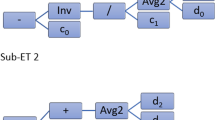Abstract
An attempt was made to model input-output relationships of an electrical discharge machining process based on the experimental data (collected according to a central composite design) using multiple regression analysis. Three input parameters, such as peak current, pulse-on-time and pulse-duty-factor, and two outputs, namely, material removal rate (MRR) and surface roughness (SR) had been considered for the said modeling. The value of regression coefficient was determined for each model. The performances of the developed models were tested with the help of some test cases collected through the real experiments and were found to be satisfactory. It had been posed as an optimization problem and solved using a genetic algorithm to determine the set(s) of optimal parameters for ensuring the maximum MRR and minimum SR. It was also formulated as a multi-objective optimization problem and a Pareto-optimal front of solutions had been obtained.








Similar content being viewed by others
References
G.F. Benedict, Nontraditional Manufacturing Process, Marcel Dekker, New York, 1987
J.H. Holland, Adaptation in Natural and Artificial Systems, The University of Michigan Press, Ann Arbor, MI, 1975
D.K. Pratihar, Soft Computing, Narosa Publishing House, New Delhi, 2008
G. Petropoulos, N.M. Vaxevanidis, and C. Pandazaras, Modeling of Surface Finish in Electro-Discharge Machining Based Upon Statistical Multi-Parameter Analysis, J. Mater. Process. Technol., 2004, 155–156, p 1247–1251
M.G. Her and F.T. Weng, A Study of the Electrical Discharge Machining of Semi-Conductor BaTiO3, J. Mater. Process. Technol., 2002, 122, p 1–5
I. Puertas and C.J. Luis, A Study on the Machining Parameters Optimization of Electrical Discharge Machining, J. Mater. Process. Technol., 2003, 143–144, p 521–526
I. Puertas, C.J. Luis, and L. Alvarez, Analysis of the Influence of EDM Parameters on Surface Quality. MRR and EW of WC-Co, J. Mater. Process. Technol., 2004, 153–154, p 1026–1032
K. Kanlayasiri and S. Boonmung, Effects of Wire-EDM Machining Variables on Surface Roughness of Newly Developed DC 53 Die Steel: Design of Experiments and Regression Model, J. Mater. Process. Technol., 2007, 192–193, p 459–464
D. Kanagarajan, R. Karthikeyan, K. Palanikumar, and J. Davim, Optimization of Electrical Discharge Machining Characteristics of WC-Co Composites Using Non-Dominated Sorting Genetic Algorithm (NSGA-II), Int. J. Adv. Manuf. Technol., 2008, 36, p 1124–1132
K. Deb, A. Pratap, S. Agarwal, and T. Meyarivan, A Fast and Elitist Multi-Objective Genetic Algorithm: NSGA-II, IEEE Trans. Evol. Comput., 2002, 6, p 182–197
P. Matoorian, S. Sulaiman, and M.M.H.M. Ahmad, An Experimental Study for Optimization of Electrical Discharge Turning (EDT) Process, J. Mater. Process. Technol., 2008, 204, p 350–356
A. Mohammadi, A.F. Teharani, E. Emanian, and D. Karimi, Statistical Analysis of Wire Electrical Discharge Turning on Material Removal Rate, J. Mater. Process. Technol., 2008, 205, p 283–289
M.J. Haddad and A.F. Tehrani, Investigation of Cylindrical Wire Electrical Discharge Turning (CWEDT) of AISI, D3 Tool Steel Based on Statistical Analysis, J. Mater. Process. Technol., 2008, 198, p 77–85
S. Sarkar, M. Sekh, S. Mitra, and B. Bhattacharya, Modeling and Optimization of Wire Electrical Discharge Machining of γ-TiAl in Trim Cutting Operation, J. Mater. Process. Technol., 2008, 205, p 376–378
D.C. Montgomery, Design and Analysis of Experiments, Wiley, New York, 2001
Minitab 14, Statistical Software, www.minitab.com
Acknowledgments
The authors gratefully acknowledge the help and cooperation of Mr. S. Bag and Mr. S. Patra of IIT Kharagpur, India, in carrying out the real experiments.
Author information
Authors and Affiliations
Corresponding author
Appendices
Appendices
Rights and permissions
About this article
Cite this article
Maji, K., Pratihar, D.K. Modeling of Electrical Discharge Machining Process Using Conventional Regression Analysis and Genetic Algorithms. J. of Materi Eng and Perform 20, 1121–1127 (2011). https://doi.org/10.1007/s11665-010-9754-6
Received:
Revised:
Published:
Issue Date:
DOI: https://doi.org/10.1007/s11665-010-9754-6




